This post is all about the most famous monuments and landmarks in France!
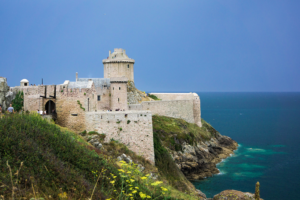
France might not be the biggest country in the world, however, it is full of incredible monuments and landmarks.
Some of the historical monuments below are world-famous and you might have heard of them. I added them nonetheless to the list in case this is your first trip to France.
Some of the below-listed places might already be on your list because they are just that famous. However, you might find some hidden gems that you definitely should add to your itinerary!
I tried to have the most famous landmarks in each region of France so that if you are traveling in France, you’ll always have something on your list to see.
If you are considering traveling by train in France, check out this post to help you book your tickets!
Let’s get started with the 41 most visited monuments and landmarks in France!
France’s most famous monuments and landmarks
Ile de France – Paris
We’ll start in the Ile de France region, which has Paris at its center since it might be your starting point. You’ll find a list of all the main landmarks you should definitely hit whilst vising the French capital!
1 – The Louvre Museum
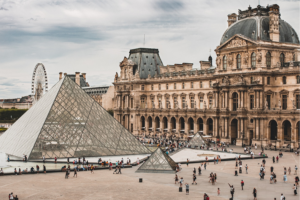
The Louvre is the most visited monument in France and the most visited museum in the world. So does it even need an introduction? Not sure, but here goes the condensed version.
The Louvre is the world’s largest art museum with around 72 735 square meters of exhibitions.
It all started with a medieval castle in the 12th century, nothing as big as we know the Louvre to be today. In the course of the 14th century it became a royal palace for French Kings. The building continued to transform and evolve over the centuries up until the mid-17th century when the Sun King Louis XIV decided to transfer the royal residence to Versailles.
The Louvre stayed as it was and waited for a new purpose. It was not until the 18th century and the French Revolution that it was decided to transform the Louvre into a museum.
Since it is such a big attraction in France and in Paris, you should definitely plan your visit in advance and expect some queuing to get in. Also, be aware that you’ll not be able to visit the whole museum in one day. Decide in advance which wing you’d like to visit. Navigate the Louvre website to find out more and book your tickets!
2 – The Palace of Versailles

As a perfect continuity: the Versailles Palace! Again this is one of the most famous French landmarks and a UNESCO World Heritage site.
This historical monument has been the main residence place of French kings for a century. Prior to being the magnificent palace, we know it to be today, there was only a hunting lodge.
King after King the building changed, expanded, and transformed, especially under the Sun King.
There are many things to visit in the Versailles Palace: the main palace, the beautiful gardens with water features, the Petit Trianon (Queen Marie Antoinette’s refuge), and much more. You should consider taking a guided tour to get the most out of your visit. It’s the perfect day trip from Paris!
If you want to learn more about having the perfect day in Versailles go over to that post!
3 – The Eiffel Tower
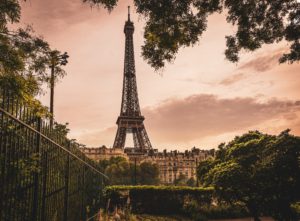
This is the proud work of Gustave Eiffel and the symbol of Paris: the Eiffel Tower! It was built in 2 years for the Universal Exhibition of 1899. It has been so popular that since 1991 it is on the UNESCO World Heritage site list.
It’s right at the end of the Champ de Mars, overlooking the Seine River.
It is the tallest structure in Paris (330 meters) and you can “visit” it, either by going to the second floor or to the top. You’ll have a nice view of Paris!
However, you must know that this is a popular tourist attraction, so be ready for some crowds. Be sure to book your tickets beforehand or you’ll have to face some very long queues to get in.
4 – The Arc de Triomphe
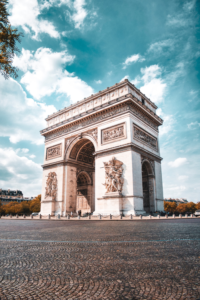
The Arc de Triomphe is located on the most famous roundabout in France: the Place de l’Etoile or the Place Charles de Gaulle.
It was built upon the request of the emperor Napoleon I. He wanted the soldiers that came back from his Napoleonic wars to come home by passing under an arch. It was the symbol of the victory of the French army. Just like the ones that existed under the Roman Empire. It took 30 years to build it and Napoleon was not able to see it finished.
It’s on the axis going from the Defense to the Louvre pyramid. To best enjoy this view you should go up the Arc de Triomphe.
5 – Les Invalides
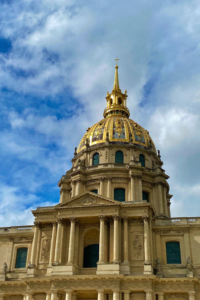
The construction of this monument was ordered by King Louis XIV. Its purpose was to be a hospital for wounded soldiers.
The building served a dual purpose for the king. It gave soldiers coming back from the war a place to live, so they did not wander around Paris sleeping on the streets. In addition, the magnificent building was a way to show his appreciation to his soldiers. The king wanted to improve his popularity among civilians and show them what they could get if they joined his army.
The Invalides is not just a hospital. There is also a cathedral inside, the Saint-Louis Cathedral. This is where you’ll be able to see the tomb of Napoleon.
Today, the Invalides also houses a museum, the Museum of the Army.
It’s a very nice visit and one of my favorite buildings in Paris.
6 – The Centre Pompidou
This is a very famous modern art museum right in the heart of the French capital.
The French President George Pompidou is the reason this place exists since 1977. He was a huge modern art fan and wanted a place for this art to flourish.
You’ll find many different forms of art here: sculpture, painting, photographs, design, and cinema…The museum’s purpose was to give France a place to display its modern art and stay a place of creativity in the modern era. It also houses a public library.
The building in itself is unlike any other in Paris, very industrial. You’ll get a great view of it from the Montparnasse Tower.
7 – The Orsay Museum

The Orsay Museum is a great place to go to if you love the impressionist movement in painting. It has the largest collection of impressionist paintings in the world!
Besides the permanent collections, there are also plenty of temporary exhibits that you’ll be able to enjoy.
This location was a former train station that has been transformed into a museum. So be sure to enjoy the building, and take pictures on the 5th floor of the clock.
If you are planning on visiting it, be sure to book your tickets in advance! It’s a very popular place for both tourists and Parisians. You’ll need to book a specific time to get into the museum, but be careful, if you’re planning on seeing a temporary exhibition your tickets also include that exhibition. Otherwise, you might have to cue again inside the museum just to see the temporary exhibition.
8 – La Cité des Sciences et de l’Industrie de la Vilette
This is a great place to go to with children: a museum with the purpose of getting kids excited and more knowledgeable about science. It’s located in the la Villette parc, which is a favorite of French families on the weekend.
In fact, it’s more than a museum. You have a cinema, an auditorium, an aquarium, a restaurant, and so much more. Plenty to explore! Check out their website to explore the program and all the temporary exhibitions.
You have plenty of space, no cars, bike lanes, and the Seine River, what more would you want?
9 – Notre Dame Cathedral
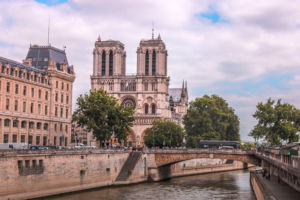
This cathedral is probably the most famous church in Paris, especially after the devastating fire that destroyed parts of it back in April 2019.
The construction started in the course of the Middle Ages in the year 1163. It took a long time to finish: almost 2 centuries!
This is the same church in which Napoleon I was crowned Emperor.
Besides some of these major historical events, the French writer Victor Hugo wrote “Notre-Dame de Paris”, which Disney turned into the animated movie that we all know.
For the moment you cannot visit this landmark, as the works to restore it are in full force. The plan is to have the cathedral reopened for the 2024 Olympic Games held in Paris. So fingers crossed!
10 – Opera – Palais Garnier

It’s a national theater in Paris where you can enjoy a ballet or a concert. It’s quite central in Paris, you just have to get off at the métro station “Opera” on lines 7, 8 or 3. The building is beautiful on the outside and even more spectacular on the inside.
It gives Versailles’ Hall of Mirrors vibes, despite the fact that it was built in the 19th century.
If you’re not interested in sitting through a concert or a ballet, you can take the guided tour of the Palais Garnier. They’ll give you all the details of the building.
11 – Pont Neuf
This is the oldest remaining bridge in Paris.
I wrote a post all about the must-see bridges in France including the Pont Neuf. Go check it out for more information!
12 – Tour Montparnasse
This is not the most beautiful landmark in Paris, it’s an office building. However, the last floor has a restaurant and a terrace with a panoramic observation deck. From up there you can admire the view of…the Eiffel Tower and Paris in general.
If you’re going in the wintertime, you’ll be able to enjoy an ice rink at the top.
You’ll either have to book a ticket to get up to the observation deck or book a table at the restaurant on the top and enjoy some quite expensive food with a view.
Pays de la Loire
We’re now changing regions and going to the Loire River area with all its castles and winery.
13 – Le Puy du Fou
Le Puy du Fou is a historical theme park in the Vendée region.
It all began with a 15th-century castle in ruins that inspired Phillipe de Villiers to write a show. From there the Puy du Fou park evolved into something much bigger with around 30 shows covering the history of the Vendée region from the Middle Ages all the way up to World War II.
During the day you can see many different shows and get an understanding of how farmers lived throughout these times. The biggest show happens at night and ends with beautiful fireworks.
Besides the shows, there are 4 villages you can walk through and enjoy this historical immersion.
You can book your ticket on their website.
14 – Château des Ducs de Bretagne
If you’re ever going to Nantes, you should check out the Ducs de Bretagne castle. You cannot miss it, it’s right in the city center.
The castle was built to defend the city of Nantes and belong to the Ducs of Bretagne since the 13th century. At that time Brittany was not part of the kingdom of France. It’s only through the arranged and political weddings of the 2 Kings of France that Brittany and France became one kingdom.
Today you can visit the castle, which was transformed into a museum. You’ll learn everything there is to know about the city of Nantes from its origins up to nowadays.
15 – Abbaye Royale de Fontevraud
This is one of the biggest abbeys in Europe. it is the seat of the Fontevraud order that was founded in 1101.
The grounds of the abbey are beautiful and quite large. It used to house both men and women up until the French Revolution. At that point, it was transformed into a prison. The building continued to be used as a prison until 1963.
There used to be 4 monasteries, but only 2 remain today and can be visited.
Since 2000 the abbey has been added to the UNESCO World Heritage site list as many other sites and landmarks in the Loire Valley.
Occitanie
We are now moving to the south of France in the Occitanie region.
16 – Pont du Gard
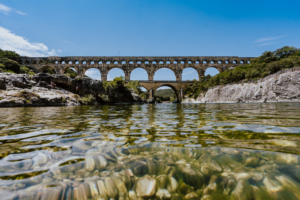
This is one of the great bridges of the region and of France. This used to be a Roman aqueduct to bring water to the nearby Roman cities.
This is an amazing piece of history that is still in great condition today. Just imagine that this was built in the 1st century of our time! It’s the highest bridge from that era.
17 – Millau Viaduct
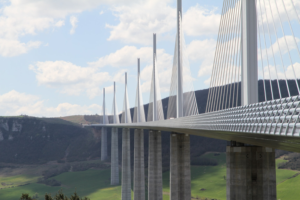
This fairly recent (2004) cable-stayed bridge is another quite famous one that you can find in this region. It is also the highest bridge in Europe and took 13 years to be built. They first had to see if it was technically feasible and then had to assemble all the funds.
You might just experience it by driving on it or make a quick picture stop just before driving on this majestic bridge.
18 – La Cité de Carcassonne
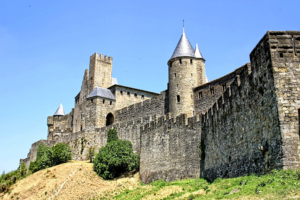
This is a little jewel in Southern France that you’ll need to discover! A medieval fortified city that has been here since Roman times.
There is a medieval castle, a basilica and the fortifications that you can experience.
This whole part of the city of Carcassonne was falling to ruin until an archeologist fought for it to be brought back to its former glory. Thanks to his determination the cité de Carcassonne was fully restored and is now one of the French monuments that are on the UNESCO World Heritage site list.
Centre Val de Loire
The Loire Valley is a favored destination by tourists and French alike. There are many beautiful castles, wineries, good food, and great nature to experience.
The easiest way to navigate in the Loire Valley is probably by car, though there are many bikeways!
19 – Château de Chambord

Let’s start with the Château de Chambord, which is one of my favorites. It’s probably one of the biggest castles in the area and I find the most majestic. The park surrounding it is quite vast and very enjoyable if there is good weather. There are even hunting grounds attached to this domain.
It’s King François 1st that ordered the transformation of the old fort into the magnificent château it is today.
When you’re visiting the castle today, it’s mostly empty. Only a few rooms have some furniture and paintings. This is the perfect representation of how things were back then: empty until the King arrived with all his things, furniture, carpets, paintings, and people.
You can climb all the way up to the roof and get a closer look at the towers and a beautiful view of the grounds.
20 – Château de Chenonceau
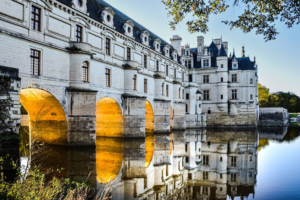
The château de Chenonceau is another beauty of the region. It’s mostly famous for its 2-story gallery constructed over the Cher River.
The nickname of this castle is “the Ladies’ castle” because it was women who were behind the construction, transformation, and development of this wonderful place.
Contrary to the previous castle, this one is furnished and will give you a better idea of how people were living at the time.
There is also a beautiful garden à la française in front of the castle and you might see some people kayaking on the Cher River.
21 – Le Clos Lucé
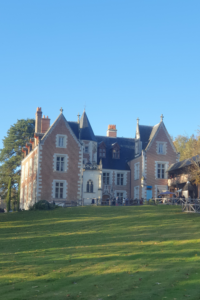
This last place is a special place: the last home of Leonardo Da Vinci. Upon the invitation of the French King François I, Leonardo left Italy forever with some of his major work (including the Mona Lisa). This was the castle in which King François I grew up.
Leonardo lived there for the 3 last years of his life completely funded by the French King, who saw a mentor in him. They both spent plenty of time together and dreamed of the perfect city together: Romorantin.
This is also where Leonardo designed the double revolution staircase that you can see in the Château de Chambord.
In the garden of the Clos Lucé, you’ll see some of the machines that Leonardo designed. There are many places to discover in the garden, so take your time here!
Normandie
Let’s go to Normandy, the beach, fresh air, and beautiful landscapes.
22 – The Mont Saint Michel
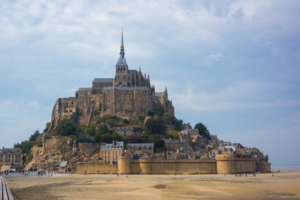
Mont Saint-Michel is quite a unique place in France. The abbey of Saint Michel is on a rock formation right in the middle of the bay.
There has been a religious community since the 12th century, though there had been 2 oratories since the 6th century on that same rock. After the installation of the religious community, villagers fleeing Viking attacks came looking for refuge. They installed their settlement at the bottom of the abbey of Saint Michel.
The tide can come up to the bottom of the rock on which the abbey is built. Nowadays there is a bridge to help you access the site. However, if you wish to further explore the bay surrounding the Mont Saint Michel you will have to wait for the low tide and get a guide!
The visit is great, though most of the rooms are empty. Nonetheless, the abbey is still magnificent, and if your visiting it during the summer months you could catch the sound and light show. It gives the whole space another atmosphere. Be prepared for crowds, it’s a very popular spot!
23 – Omaha Beach
This is one of the 5 beaches on which the Allies landed during World War II. Omaha refers to an 8 km stretch of beach in Normandy.
There are still some remains of WWII that you can see on the beach.
Grand Est
Let’s go east of France and discover all the wonderful monuments and landmarks!
24 – The Reims Cathedral
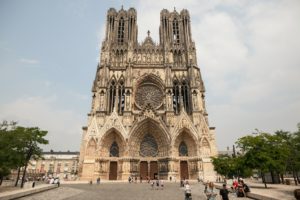
Reims is at the heart of the Champagne region of France with around 200 000 inhabitants. This in itself might be good enough to go to Reims, but there is more history to the city that should pique your interest!
Reims is also known to be the city of Kings: 31 French kings for over 10 centuries have been crowned in the Notre-Dame cathedral.
The cathedral you’ll see today was built after the previous church of Reims caught fire. The construction of the new cathedral started in 1211.
The cathedral was spared during the French Revolution contrary to other symbolic churches such as the Cathedral of Chartres.
It has not been as central to the political life of France since the revolution. It was bombed during WWI and the French and German presidents started the route to reconciliation in this cathedral in July 1962. So it has still played an important role in modern times!
25 – Cathédrale de Strasbourg
Strasbourg is another famous city in the East of France, especially at Christmas time for its famous Christmas markets. Every year lots of French and tourists alike make the trip to the city to get in the Christmas spirit.
In fact, the Christmas market takes place in parts just in front of the Strasbourg cathedral.
The construction of this Gothic cathedral started in 1176 however, it was not finished before 1439. For 2 centuries it was the tallest building in the world. This reign ended in 1874. It is still the second most visited cathedral in France, just after Notre Dame de Paris.
26 – Château du Haut-Kœnigsbourg

This is a wonderful 12th-century medieval castle right in the heart of the Alsace region. If you or your children are fans of the Middle Ages this is definitely a place you’ll enjoy visiting.
You’ll witness a forge, a mill even an inn inside the castle grounds. The rooms you’ll visit will give you a great idea of how the various lords lived.
The castle was built on a hill, for a more strategic defensive position and a 360 view. Today it gives you a great view of the valley and the Vosges mountains.
Auvergne Rhône Alpes
Let’s stay in the mountain area and move to the Savoie region.
27 – The Mont Blanc (& téléphérique de l’aiguille du midi)

Mont Blanc is the highest mountain in Western Europe and is part of the border between France and Italy. The highest point of Mont Blanc reaches 4 808 meters.
You can get a great view of Mont Blanc from different high-altitude stations like Chamonix or Les Arcs.
If you’re in Chamonix, you could also take the highest cable car in France: the téléphérique de l’Aiguille du Midi. The Aiguille du Midi is 3 842 meters high and from up there, you’ll have the most amazing view: a real sea of snow and the Mont Blanc!
28 – Lac d’Annecy

This is a very famous lac in the Savoie region, named after the city of Annecy. It’s the 3rd largest lake in France.
The lake was formed by a glacier melting around 17 000 years ago. Today there are still 7 rivers feeding the lake.
It’s a very popular spot, especially during summer for all types of water sports. There are also a lot of magnificent properties around the lake.
Provence-Alpes-Côte d’Azur
We are now going south to the Provence region, which has some lovely landmarks to be explored!
29 – Palais des Papes (Avignon)
This is a pontifical residence dating back to the Middle Ages built in the city of Avignon overlooking the Rhône River. It was during the 14th century that this place was at the center of Christian history. The architecture of the building is Gothic.
The first palace was built to house the Pope who did not wish to move to Rome. The choice was made to build a palace in Avignon and this first palace was finished in 1322. This was only a starting point. The palace as we can see it today has been the object of constant reworks, extension, and embellishments.
The whole palace is so magnificent that it has been added to the UNESCO World Heritage Site list.
30 – Lavender fields of Provence
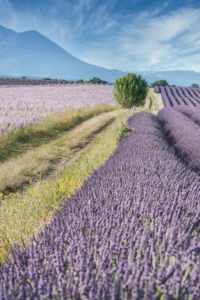
How many Instagram posts did you see of those beautiful lavender fields? There are beautiful and make for a great picture for sure!
The best time of the year to get that shot is between mid-June and the beginning of August. You’ll have the field in full bloom. Once harvested the lavender is used for the production of essential oil.
There are 3 main areas you could go to:
- the Plateau of Valensole: this is probably the most well-known place to see lavender. There are over 800 km2 of fields that you can explore in the middle of the Provence
- the Plateau des Claparèdes
- the Plateau d’Albion
Get in touch with a local agency to plan a visit!
31 – Gorges du Verdon
This is a river canyon in the middle of Provence about 25 km long and 700 meters deep. The canyon was created by the Verdon River which eroded the limestone over the centuries and decades.
It is particularly popular because of the beautiful turquoise color of the water. It is a great family summer destination, especially for any water sports lover.
Hauts de France
The Northern part of France maybe less well-known by tourists and it is unfortunate because there are some jewels to be discovered for sure!
32 – Chateau de Chantilly

The first jewel is the Chateau de Chantilly which is only 1 hour away from Paris. I’ve written more on this place in this post, so go check it out!
33 – Chateau de Pierrefonds
This is another medieval castle from the 14th century in perfect condition just a bit over 1 hour away from Paris. The castle was restored during the course of the 19th century and is now used for TV shows and movies.
The castle has been the residence of members of the royal family, dukes, and future French Kings. It was partially demolished during the 17th century. However, a new love for medieval buildings and castles turned the attention of the last king of France Louis-Philippe towards the Chateau de Pierrefonds. The restoration began under Napoleon III.
You’ll be able to visit a great number of rooms in the castle, the gardens, and the donjon. This is a great place for families!
Brittany
34 – Cap Fréhel
This is a peninsula in northern Brittany, in the Gulf of Saint-Malo. There is nothing much besides 2 lighthouses at the tip of that peninsula. One of the lighthouses is from the 17th century, while the other is more recent, going back to 1950. the 1950 lighthouse is a reconstruction post World War II.
The cliff on which both lighthouses are situated is about 70 meters high. it is one of the highest in Brittany.
During World War II the most recent lighthouse was used as a radar station.
35 – Fort la Latte

This castle is very close to the Cap Fréhel, just one peninsula away, on the la Latte peninsula.
The castle was built at the very tip of the peninsula, making it almost impossible to invade by sea. The construction started in 1340 and its donjon was built around 1370.
It’s quite a quick visit, most of it is open to the elements, so make sure you go on a sunny day! It’s a great experience for the whole family.
36 – Old town of Saint-Malo
One of the main cities of Brittany is Saint-Malo. The Old Town more specifically is very charming and really worth spending a few days in.
Though you’ll find many modern shops, just walking in these old streets eating a crêpe or on the city walls is very enjoyable.
Saint-Malo is right by the sea, and in summer you can even go for a (very) refreshing swim in the Manche. This is truly a beautiful city: the sea, the fortified city, sometimes some fog sometimes sunshine.
You could also enjoy a thalasso in one of the nicer hotels right on the shores.
Nouvelle Aquitaine
We’re staying in the Western part of France, but are going south first to La Rochelle and then to Bordeaux!
37 – Tours médiévales de la Rochelle
La Rochelle is right by the Atlantic Ocean and played an important role in commerce and as an ocean gate to France. There are indeed 3 medieval towers whose role was to regulate the circulation of the ships coming in and out of the La Rochelle port.
The three towers are Tour Saint-Nicolas, Tour de la Chaîne, and Tour de la Lanterne.
All three towers were built as places of residence, however, during the 16th and the 18th centuries two of them were transformed into prisons. The Tour de la Lanterne also worked as a lighthouse.
If you want to have a great view of the city, go to the top of the Tour Saint-Nicolas!
38 – Place de la Bourse (Bordeaux)
Bordeaux is a beautiful city with a long history. At the heart of the city, you’ll stumble upon the Place de la Bourse. This open square is one of the most remarkable landmarks of the city. It is constituted of the Hotel de la Bourse (which houses the Chamber of Commerce of Bordeaux and the Commercial Justice court) and the Hotel de la Ferme (which houses the Customs office and a customs museum), both built between 1730 and 1755.
The buildings are a perfect representation of French classical architecture. In the center of the square, you’ll find a fountain with a representation of the Thre Graces. Prior to the fountain, there was a huge metal statue of King Louis XV. However, it was melted during the French Revolution and transformed into the fountain we can see today.
39 – Dune du Pilat
The Dune du Pilat is a sand dune right by the sea and the city of Arcachon. It is also the highest dune in Europe and is around 103 meters high.
You have several options to reach the dune. You could go on foot or by bike which is free. There is also a bus from the train station of Arcachon (Baïa bus) and the fair is quite cheap (approx 1€). The other option is going by car, in which case you’ll have to pay for parking (around 6€ by car for 4 hours).
The great thing about this place is that each season completely transforms the view and the experience.
I cannot resist sharing one of the great treats of this region: the dune blanche. They have a shop in Bordeaux and in Arcachon, so definitely go check out this very local treat!
Bourgogne Franche Comté
We’re on the last stretch of our roundtrip of the most beautiful monuments and landmarks in France. The Bourgogne region is very famous for its wine production, the escargots (snails), and the delicious rich food. There is even more to it: here are 3 very special places you should visit if you’re ever in the region.
40 – Hospices de Beaune
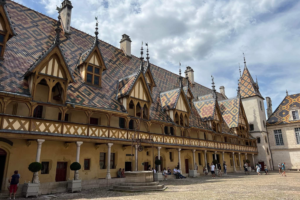
This former charitable almshouse was founded by Nicolas Rolin in 1443. All the poor from the region who needed medical treatment could come here and be looked after and taken care of for free.
The building is very typical of the region, especially the roof tiles. You can walk through most of the building and get a very good feeling of how things were at the time. The audio guide is very helpful in that regard.
I really enjoyed walking in the small city of Beaune after the visit. If you’re a wine fan, you’re in the right region!
41 – Abbaye de Fontenay
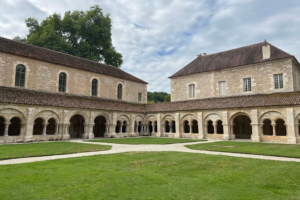
This is another very special place, on the UNESCO World Heritage list. This abbey is no longer used, however, some of the main buildings remain and can be visited. It was founded in 1118, making it one of the oldest abbey to still be standing to this day.
The atmosphere is very serene and a great visit on a sunny day, as you’ll be outside quite a bit.
To reach the abbey you’ll definitely need a car, as it’s lost in the middle of not much. You can book your visit in advance on their website.
This post is all about the 41 most remarkable monuments and landmarks in France!
Save for later on Pinterest
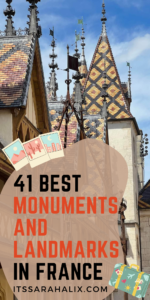
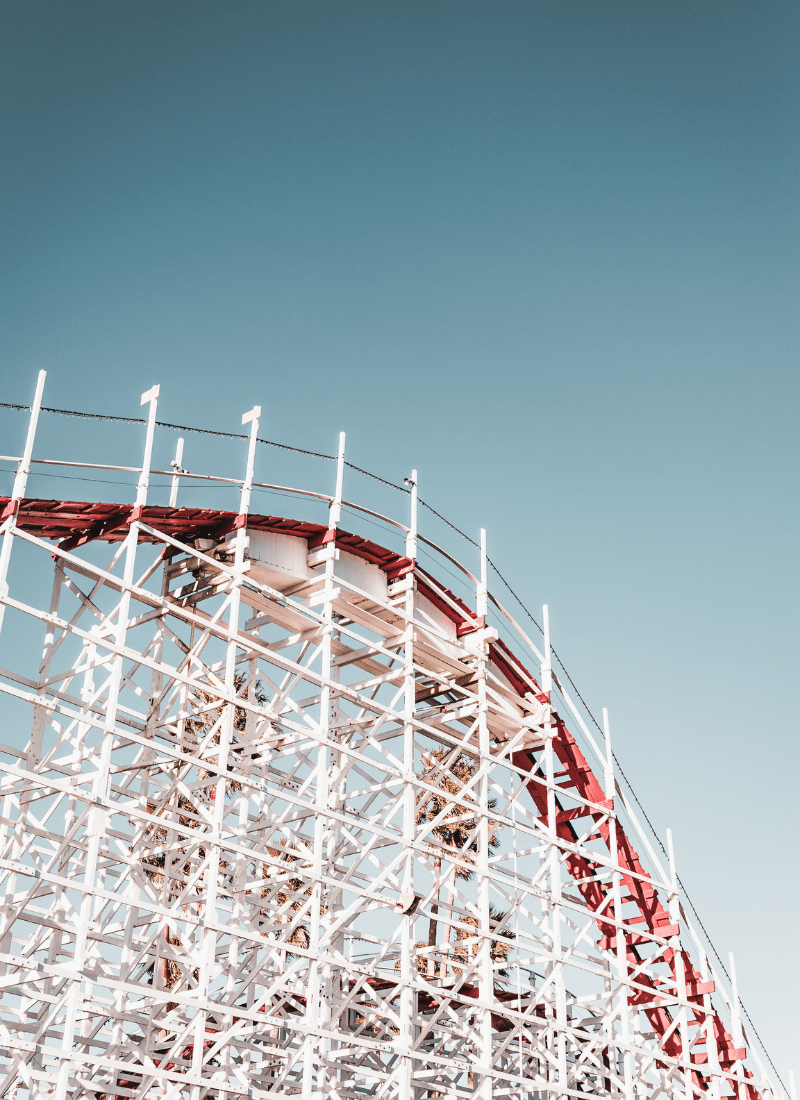


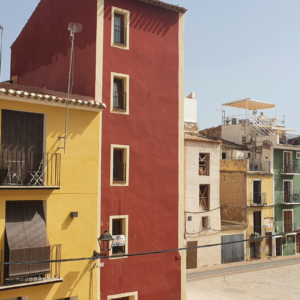
Leave a Reply